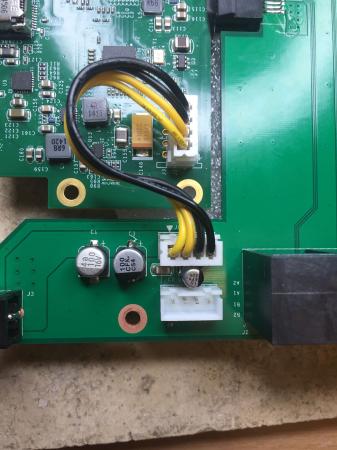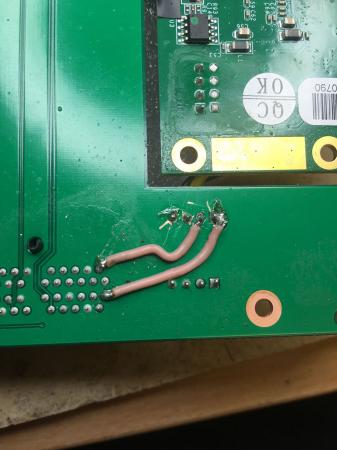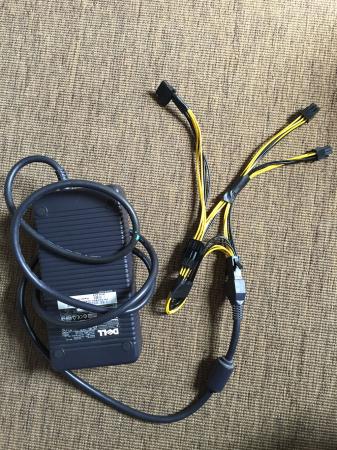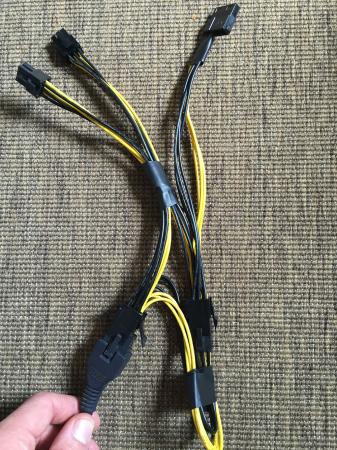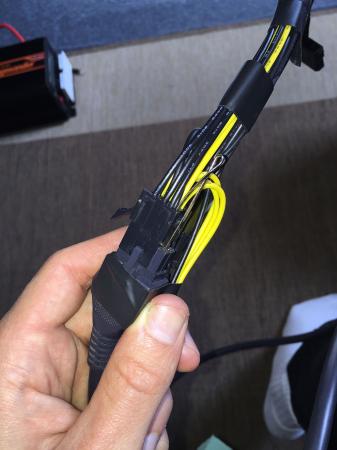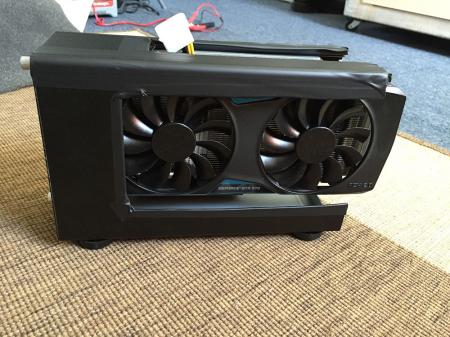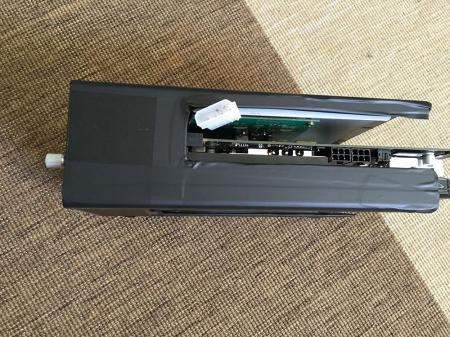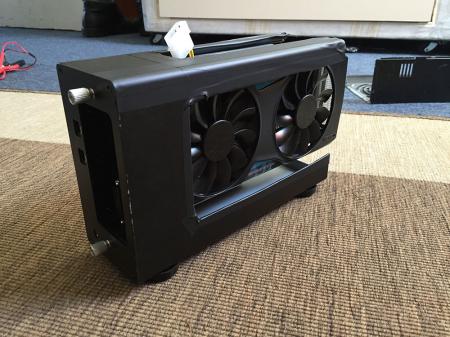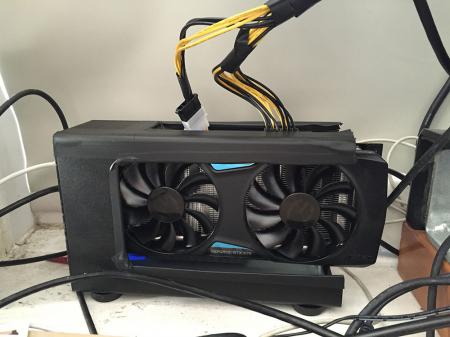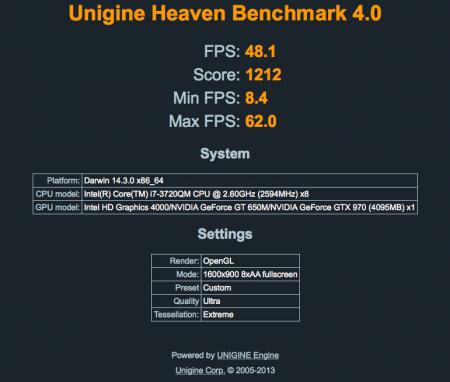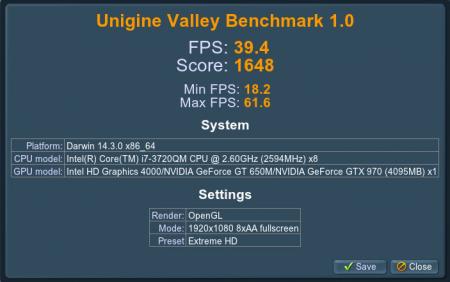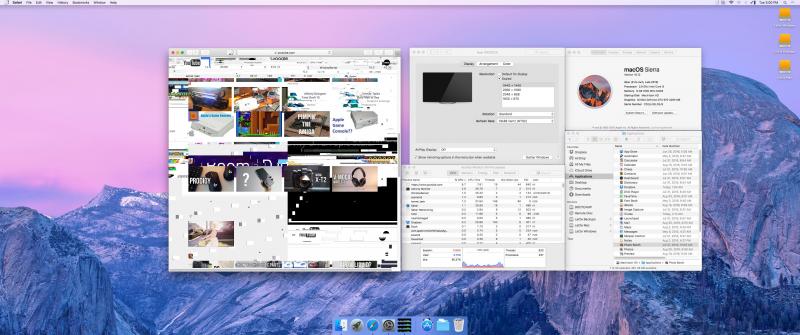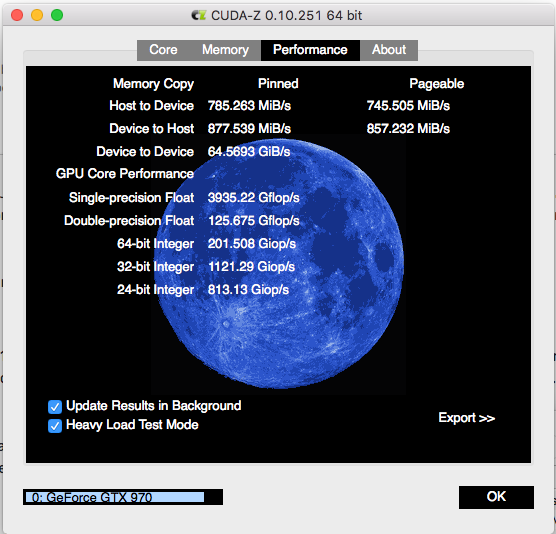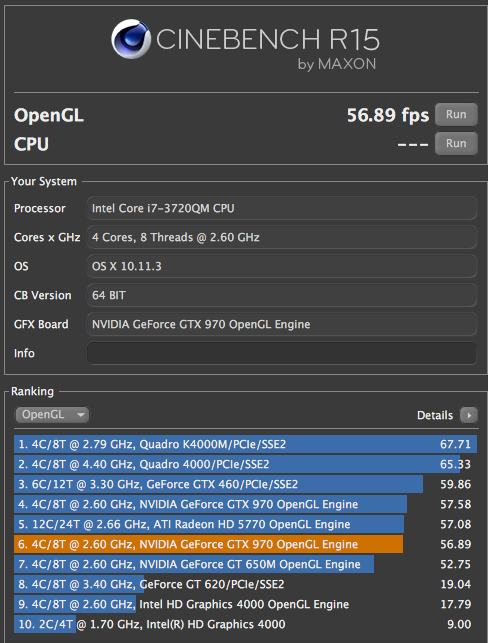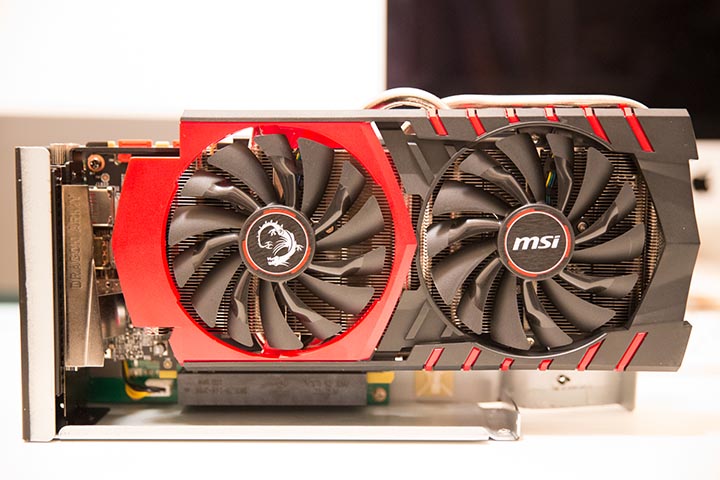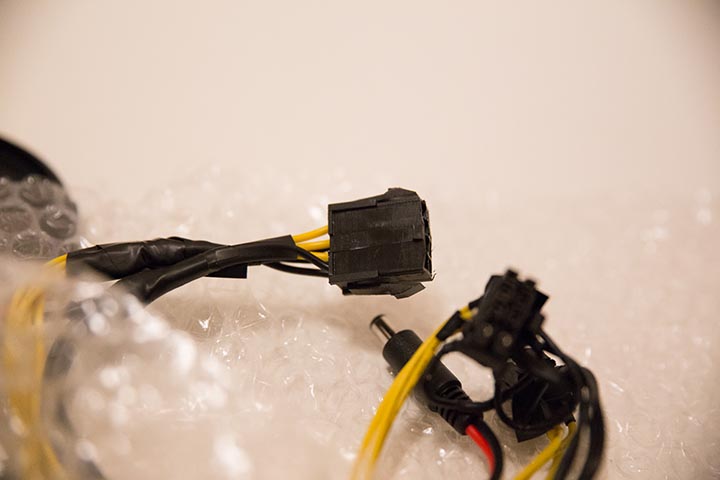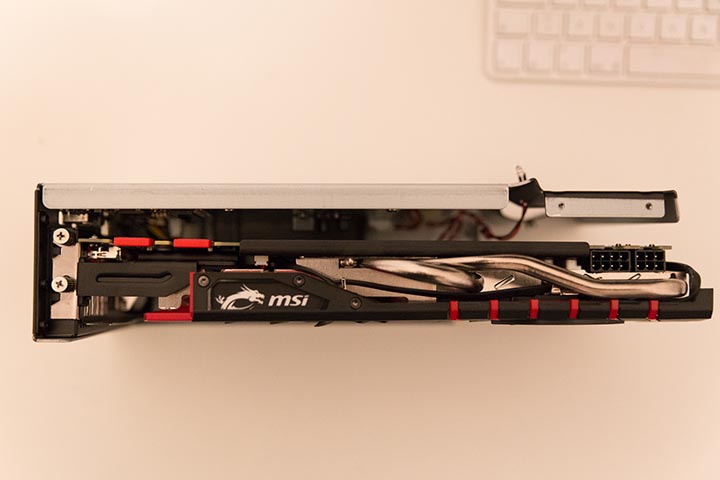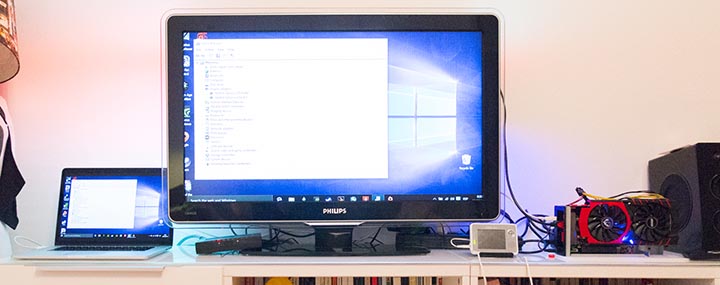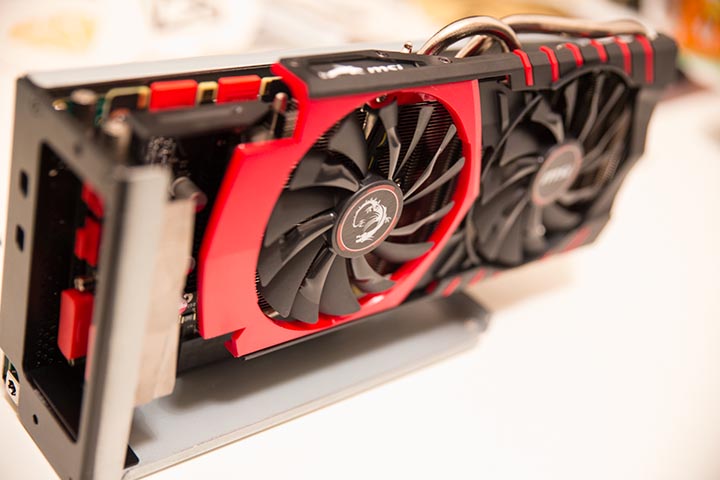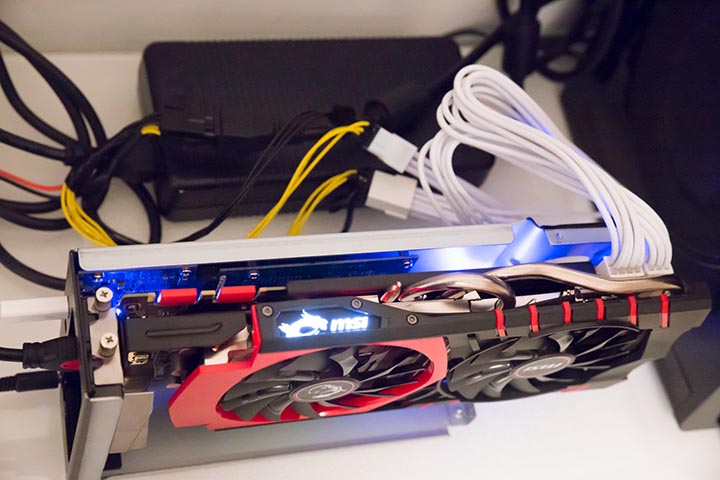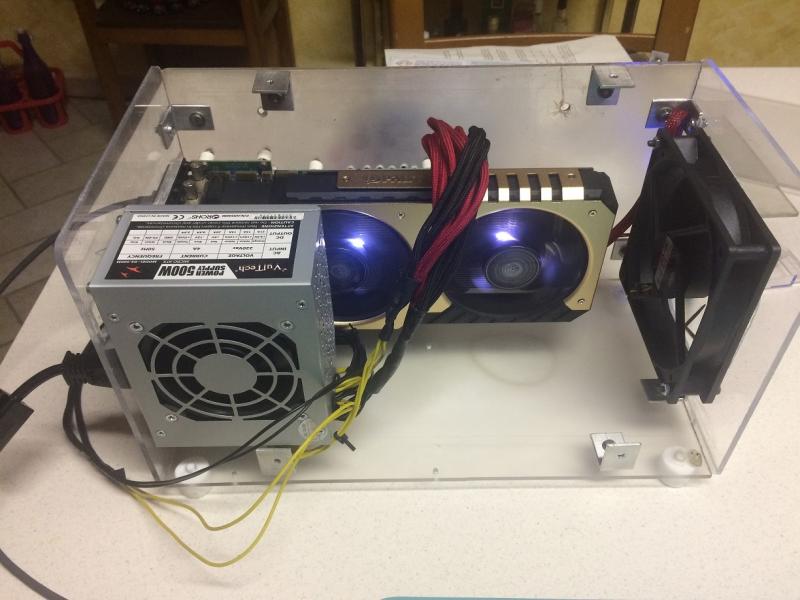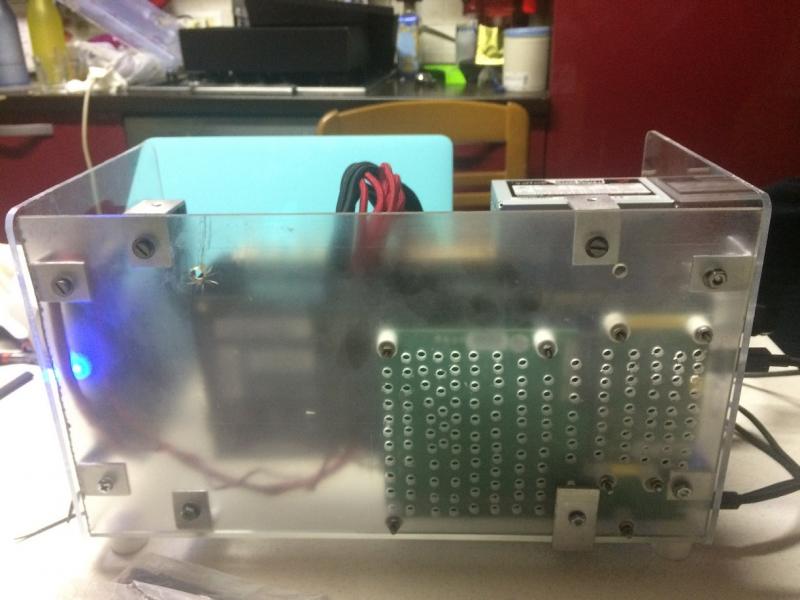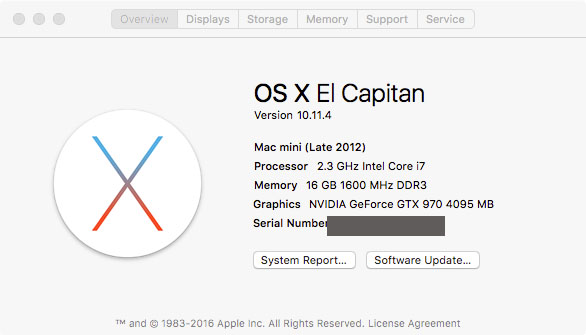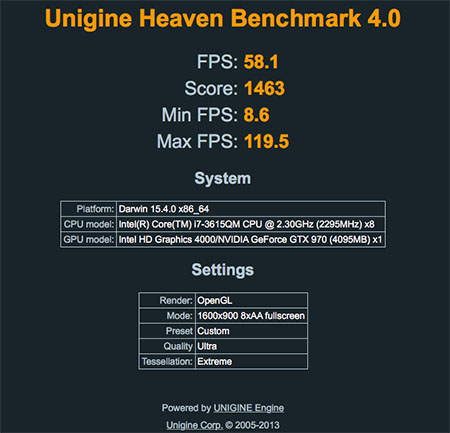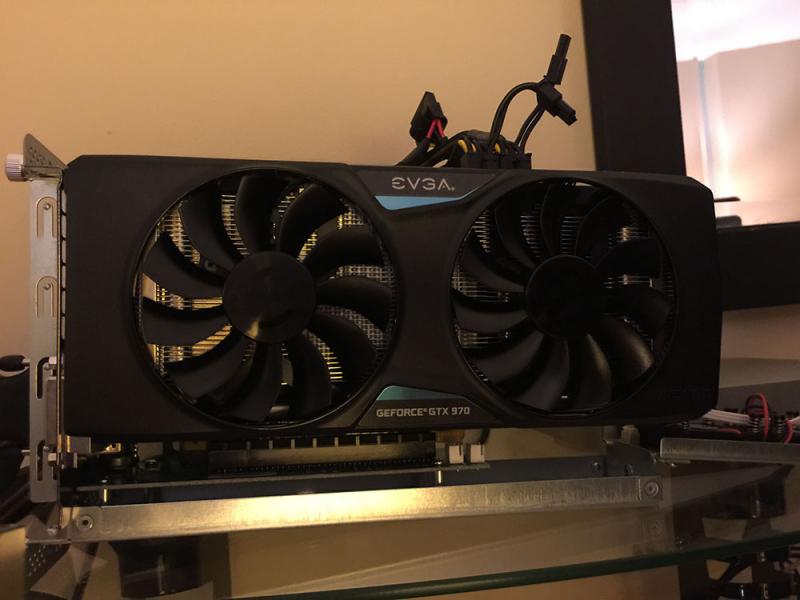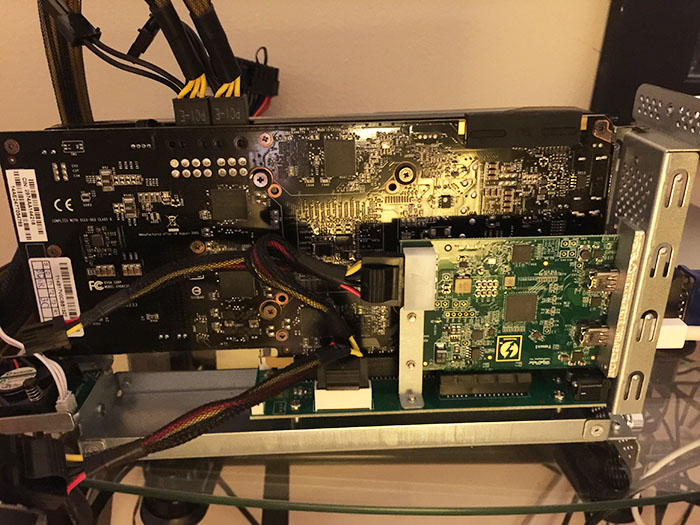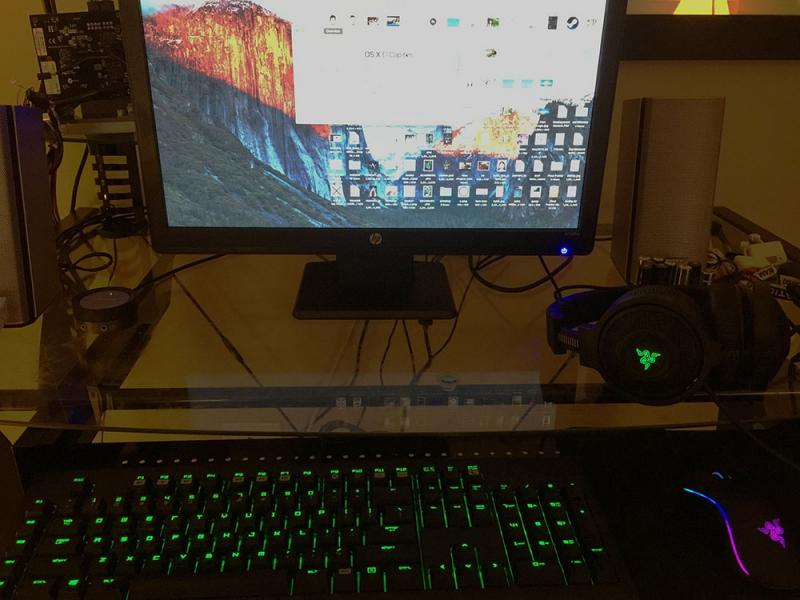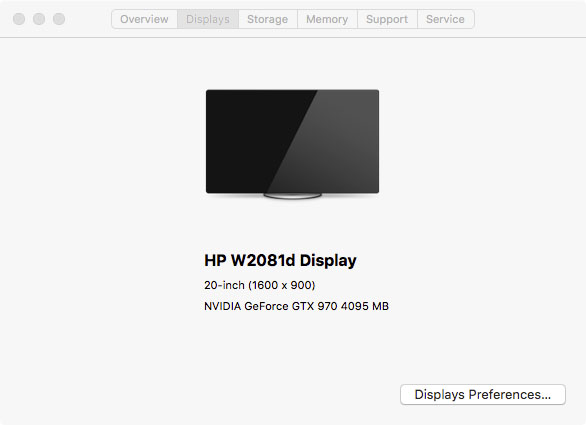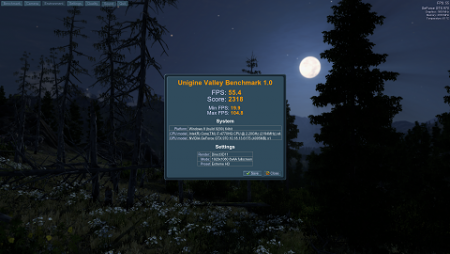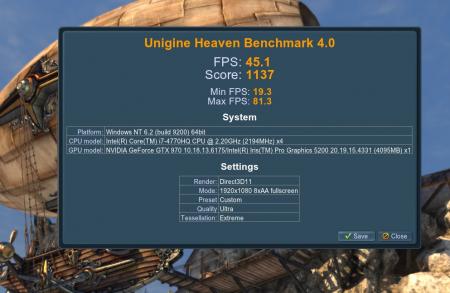Search the Community
Showing results for tags 'gtx 970'.
-
Hi, I want to show you my new project. I bought my laptop about 5 years ago. It was never speed deamon, but for every day use, it was enough to me. Its specification: Intel i7-4700MQ Nvidia GeForce GT745M 16GB RAM 512 SSD Adata SU800 Yesterday I bought Witcher 3. Of course on 1080p it's impossible to play, because of about 10fps So I make a decision to buy external grahpic card. I choose GTX970 and now I am looking for occasion to buy it. I've already bought EXP GDC v8.4d mPCI-E. It is used and cost about 30$. I will use ATX PSU to supply graphic card, because I have old desktop PSU at home. My plan: 1) unlock bios 2) buy GTX 970 3) enjoy Witcher 3! BTW I try to cool down my laptop, so I replaced thermal paste to Kryonout Thermal Grizzly and make some tests. Temperatures and fps are on screenshots. 1) laptop on table, playing GTA V 1080p - first minute (GPU core 1045MHz) -after some time, because of high temperature and GPU throlttling (GPU core drop down even to 400MHz) 2) with thermalpad Glacier NC400 SilentiumPC - 30 minute and longer (GPU core drop to about 900MHz) 3) without down case of laptop (like on picture with thermal paste) on thermalpad. Here laptop never drops down MHz and max temp are about 72 Celsius degrees. Bacause of that I bought second down case for my laptop and I will cut there additional holes. Greetings! I will describe next step when I get all stuff I need!
-
Hi everyone, I've made this post to gather as much information of the problem I'm facing with my Gtx 970 egpu setup, so if anyone is suffering something similar it would be really helpful if you could share your setup too. My Lenovo y510p Setup: Cpu: intel i7-4700MQ 8gb of ram Windows 8.1 Bplus PE4C v3.0 adapter mPCIe Gpu: MSI Gtx 970 (4gd5 oc) Evga 500 power supply My setup is working find without errors but whats bothering me is that when I'm using Internal Screen to play my fps won't go beyond 48-49fps no matter how old the game is DX9, DX10-11. I've tried to lower graphic settings, resolution, disable full-screen on all the games and but still stuck at 48fps. I know I should get lower performance because of internal screen but fps shouldn't be limited to 48? What I've tried but non helped : Installing different drivers. Overcloking gpu. Changing nvidia global settings, like vsync, etc.. Share Your experience if you have similar behavior on your egpu. Edit. Found Someone http://www.owen-lu.com/egpu/ with same behavior with gtx970 but using ExpressCard connection.
-
Hello guys, Thanks for this incredible forum, I hope I will learn a lot from the gurus ! I am trying to make my eGpu MSI GT X970 work on my laptop with K1100M integrated GPU. This are my specs: CPU: 2.7GHz Intel Core i7-4800MQ (quad-core, 6MB cache, up to 3.7GHz with Turbo Boost) PSU : ??? Graphics: NVIDIA Quadro K1100M / Intel HD Graphics 4600 RAM: 32 GB Storage: 1TB I got a V8.0 EXP GDC Laptop External Independent Video Card Dock with the express card version ( I am not really hw savy) and I am looking for a good psu to power my MSI GTX 970 4G Could you kindly suggest a good PSU that i could use to power this GPU ? I am also willing to do as many experiments needed Thanks for reading my post -zepvalue
-
Hey guys! Its been a week since i bought my new GTX970 and EXP GDC v.8 and a powersupply. Its not working on my laptop. I also can't tweak my bios to help setting up this graphics card.. Is there an alternative process in order to succeed installing this tech ? please help me. THANKYOU! Here is my specs. WINDOWS 10 ASUS n550jk core i7 2.5 ~ 3.5ghz 16gb ram Samsung 850 pro SSD please help me!
- 2 replies
-
- exp gdc beast v.8 gtx 970
- gtx 970
-
(and 3 more)
Tagged with:
-
Hi, After many failures here is my little contribution to this forum. This guide will be updated if I find anything new. Any question, just ask. Hardware: Macbook Pro Retina Mid 2012 (thunderbolt 1) EVGA GTX 970 Akitio box MODED AKITIO BOARD for power soldered on PCB MODED AKITIO BOARD with additional capacitors DELL DA2 PSU + MODED PCIE CABLES BenQ Monitor on HDMI Softwares: OSX 10.11.2 Windows 10 pro (Bootcamp BIOS) WebDriver: latest Cuda Drivers: latest OSX INSTALLATION: There is a script that automates the whole thing that can be found here , it worked wonderfully on my vanilla 10.11, easy as cake !! Thanks a milion @goalque For manual installation follow the video below to the letter: Stability Comments: OS X Stable Windows stable Restarting is quick (apple logo straight away) but starting the computer after a power OFF takes a good 30 sec more to get to the apple logo. Issue with safari not wanting to play netflix somehow; issue with HDCP handshake somehow, works fine with chrome. Installing Windows 10 (BIOS) (I hate windows :s ) I installed windows 10 via bootcamp, purchased EGPU setup and used the 1.2 version. I don't remember exactly how the EGPU appeared in the system infos but I think it was recognised as Nvidia gtx 970 straight away. so after you have installed the latest Nvidia drivers for your eGpu it is time to get the eGpu software running: Unzip EGPUsetup 1.2 to c:\eGpu run setup-disk-image Restart and load eGpu Setup 1.2, select option 2 Do PCI compaction all exept sata and make sure you have PCI WRITE and ALL ALLOC showing yes Optional: If freeze at the bootloader: edit PCI.BAT replacing a:x.x and b:x.x with 0a:x.x and 0b:x.x (I only found A occurences in mine) (in the editor alt/option+F to access the file menu) Optional: If the settings are not kept after reboot: edit Startup.bat by adding REM in front of all "call vidinit" like so: REM call vidinit... (in the editor alt/option+F to access the file menu) Run test startup.bat Run bootloader Select eGpu setup 1.2 again and now select option 1 If everything goes well you just have to do the last step every time you want to boot into windows with the eGpu Maybe there is a way to automate the last step but yet to find out. Easy enough for now Big thanks to @Tech Inferno Fan This setup is similar to those of bsohn and errin PHOTOS:
- 31 replies
-
- 4
-

-
Hello everyone, I am a newbie in this forum and I've known about eGpu for just a few days. So i want to ask you some questions. I have an HP Elitebook 8570p and this is my specs : Intel core i5-3320m VGA: AMD HD 7570m I am planning to use an EXP GDC beast 8.0 and there are 2 options i am wondering : radeon r9 380 and gtx 970. I like r9 380 more because it's cheaper, but someone says it's hard to set up an AMD card for a laptop which also have AMD dGPU . IN the other hand,a GTx is easier to set up and have better performance. SO which one should i buy ? Another question : As I know a core I5 CPU always have integrated card Intel HD 4000 on it, but when I check in the device manager there's only dGPU Radeon 7570m. Is it possible for me to use an EGPU? Sorry for my English . Please help me and thanks in advance
-
So, I sold my eGPU setup, which was a GTX 970 in a Thunder2 enclosure using a Corsair VS550 psu. Worked fine when I owned it, my MacBook died, so I've sold it to a friend. Set it up fine on his mid 2012 MBP no worries, everything seemed to work fine at first. Now, a day later, every time he loads heroes of the storm (or any game for that matter) the computer black screens and resets, throws up a GPU panic error code. Sometimes it will last a little longer than others, but the predominate issue is that the fans often aren't spinning when the radiator gets hot. The fans work, because they spin up on start up. Ideas for what could be causing this issue? Thanks.
- 3 replies
-
- egpu
- macbook pro
-
(and 1 more)
Tagged with:
-
Hi everybody, For some time I have been trying to solve a problem between my akitio and my graphics card. Yesterday, when I connected the port thunderbolt to my macbook, the fans of the graphics card were working. But the card was not connected. While the Akitio was running, I unplugged / reconnected the graphics card. The graphics card turned on and off, and I smelled a burning smell. This morning, I tried the graphics card on a PC, and it works well. Moreover the Akitio is detected by my macbook. It seems that the PCI port does not work? How can I test the PCI port? Do you think I have to return the Thunder2. Yohan Config : -Akitio thunder2 -RM450 (connect cart and akitio) -GTX 970
-
hi guys! I need help with my egpu. My gtx 970 with the akitio 2 works fine on my mac mini on os x 10.10.1. mow I tried it on my Macbook pro mid 2012 15" with the same os and it doesn't work. The gpu isn' recognized, System information I get NVIDIA Chip Model instead gtx 970. The drivers are the same as on my mac mini.
- 1 reply
-
- macbook pro
- akitio
-
(and 2 more)
Tagged with:
-
Hi, a week ago i decided to build an eGpu Setup for my Macbook Pro. I installed Windows 10 (excidentley deleted OS X :/) and pluged the Zotac GTX 970 via Akitio Thunderbox into my Macbook(only Supports Thunderbolt 1). The device Manager detected the eGpu and i installed the latest Driver. Now the problem, when im triyng to play for example Company of Heroes the eGPU is obviously not in action. The Company of Heroes Benchmark says something about 1-4 fps. Im very confused because when im running this Benchmark with disabled Intel hd 4000 the GTX970 works well:http://www.geeks3d.com/gputest/. please help me, its so frustrating to see the egpu running in this Benchmark and dont see it in games.
-
- egpu
- thunderbolt
-
(and 3 more)
Tagged with:
-
This is probably the first trial online involving a TB3 to TB adapter. Update on Noon July 23rd 2016: works seamlessly with an external monitor. However, whenever I select Duplicate in projection mode, the rendering will be carried out on iGPU/dGPU(if you do not disable it) Update on Morning July 23rd 2016: Turns out the Optimus is only working for Furmark. i.e. No game would run on GTX970. Nor would 3DMark. It seems an external monitor is still a necessary fix. What's working: system recognizes gpu driver installed no problem on external screen [Partially] Optimus working, just don't disable the GTX960M in Device Manager. Only works for Furmark. Background In the spring, I came to the States for one-semester exchange. I obviously couldn't get myself a full-size gaming rig, so I chose to build an eGPU with my MBPr13 2015. I got my AkiTio Thunder 2 and GTX970 then, for about $500. Later in the summer, I purchased a XPS15 (discussed by the low-voltage cpu in my MBPr 13), was enthralled by its borderless display. It came with a TB3 port, but the only option out there for TB3 is Razer Core, another $500 investment. In the mean time, A few TB3 to TB adapters rolled out, currently only Kanex and StarTech.com models available, for around $80-100. I asked a bunch of questions regarding AkiTio Thunder 2 + TB3-TB adapter + eGPU on Amazon but no luck. So I decided to get one myself and try it out. About the adapter I got it on amazon for $100. https://www.amazon.com/gp/product/B01EJ4XL08/ref=oh_aui_detailpage_o01_s00?ie=UTF8&psc=1. In fact the StarTech.com one is 20 bucks cheaper, and I believe they should harness similar technology under the hood, but I would trust Kanex for I have already owned their USB3.0 hub and it worked pretty well. The hardware setup (Picture coming soon, when I get back dorm) The software setup Download the newest NVIDIA driver. update the TB3 firmware and TB3 management software on Dell.com, or as instructed on https://thunderbolttechnology.net/updates per manufacturer. In the UEFI settings, turn on all the checkboxes in Thunderbolt tab, and make sure the thunderbolt security settings is set to lowest (Cuz Akitio Thunder 2 is not verified for TB3). Or you can manually consent in windows, if the security level is normal. Plug the setup in, and power on. Windows should boot just fine. Use display driver uninstaller to remove the old drivers. http://www.guru3d.com/files-details/display-driver-uninstaller-download.html Install the newest driver downloaded in step 1 reboot, and you should be able to see all three graphics card in Device Manager. (Intel 530, GTX960M, GTX970). You are free to disable GTX960M, but that doesn't help anything so far. :-( Result summary Geforce experience recognizes GTX970 no problem NVIDIA Control Panel recognizes all three with no problem. Under internal display, no game would run with GTX970, even after disabling GTX960M. GTX970 shows up properly in the GPU indicator, but it's always 'inactive' It works! Just don't disable GTX960M, and tasks will be automatically assigned to GTX970 when needed. Only works for Furmark. No games and 3D Mark would work. External monitor works flawlessly. Can't get 'duplicate' projection mode to work though. Trying to fix the internal display (Optimus) problem As my MP-CL1 micro projector seems to defect, I've no access to external display yet to test the card out. And I'm not yet able to get the eGPU running on internal display either. What I have tried: modifying the nvidia driver per this video, with no avail. [in progress] just purchased this headless hdmi plug to simulate a dummy display, and use Win+P with screen share option. [just contemplating] maybe should get Razer driver to work? But Razer Synapse should only recognize Razer Core, so need a side-door. They say the driver is open-source, but I cannot find it on Github anyway. Just don't disable GTX960M and it partially works (only for furmark). Maybe furmark is rendering the content internally and pipe the image out through a different gpu manually? Windows 8.1 not working. I just installed a copy on my SanDisk SSD 500 external SSD. GTX970 cannot co-exist with GTX960M, and disabling GTX960M still doesn't enable rendering on GTX970. With external display Will update once I get my MP-CL1 working (hopefully it's just a drained battery), or when I get back to Hong Kong. Just remembered there's a common area in my dorm with a TV. Got to try it out some time. Tried out on the TV, able to achieve ~20000 on Sky Diver. With GTX960M it's around half
- 18 replies
-
- 2
-

-
- akitio
- thunderbolt 3
-
(and 6 more)
Tagged with:
-
My setup: iMac Late 2013, 2.9GHz i5 PCIe: Akitio Thunder2 Pcie Box (Powered using barrel plug method) GPU: Galax Geforce GTX 970 Sniper Edition PSU: Corsair VS450W Monitor: Acer Ultrawide XR342K 34" I follow the installation guide from this videohttps://www.youtube.com/watch?v=--pL5iRhpmU I installed CUDA 8 Drivers for Mac and follow the video but then I have this problem with icon appearing as glitches and also the browser seems to glitch out. How do I fix this?
-
TL;DR: 2012 Mac Mini w/ GTX970 in AkitioTB2 setup installed smoothly & continues to work reliably. ~300% OpenGL performance increase over built-in Intel graphics. Thanks to all who came before me, especially [goalque] with the fantastic "automate eGPU" script. ------ UPDATE 2016-11-06 Setup continues to work flawlessly under OS X 10.11.6. eGPU and monitors are recognized shortly after system power-on 100% of the time. Sleep / wake works fine. Same reliability as built-in graphics, just a lot faster. NOTE, after some security updates were applied (through the App Store updater,) it was necessary to connect a display to the HDMI port, then re-run the 0.9.9 version of automate-eGPU. (But I did not have to turn off system integrity protection again.) ------ UPDATE 2016-05-26 Setup continues to work flawlessly under OS X 10.11.5. GPU / monitors are recognized shortly after system boot-up 100% of the time. Sleep / wake works fine. Same reliability as built-in graphics, just a lot faster. ------------ Setup Specs & Parts **See firmware revisions & other details in footnotes at bottom of this post. Pre-existing hardware/software CPU: late-2012 Mac Mini, Core i7/2.6Ghz (macmini6,2) / 16GB RAM / 500GB Samsung EVO 850 SSD (internal SATAIII bus) OS: OS X 10.11.4 "El Capitan." (Setup initially done & tested under Mac OS X 10.10.5 "Yosemite") Displays: 2 x DELL U2412M, 1920 x 1200 each panel = 3840 x 1200 total pixels. Each display connected via a DVI cable directly to eGPU card. Other peripherals: (2) USB 3. drive docks (for SATA drives) from different makers. Fujitsu ScanSnap ix500 (USB3). (3) printers of various kinds. All-in-one USB card reader. New eGPU hardware (all purchased through Amazon) eGPU: ZOTAC-brand GeForce GTX 970 [hereafter called "GTX970"] basic edition (2 fans,) part #ZT-90101-10P eGPU enclosure: Akitio Thunder2 [hereafter called "Akitio"] as described elsewhere on these forums. part #T2PC-TIA-AKTU eGPU external power supply (hereafter called "PSU") : EVGA "Supernova" 550G2 (550 watts), ATX-style power supply, part #220-G2-0550-Y1 eGPU cabling: good-quality GPU-card power cabling came included with the EVGA 550 G2 PSU above. I also ordered a custom-made 4-pin to 5.5/2.5mm barrel adapter to run the Akitio off the PSU, ~$20 on eBay, and a pair of low-profile, "right-handed" 6 pin cables also from eBay. Total cost ~$700 w/ tax & ship. New Software driver (free download) NVIDIA Web Driver CURRENT: 346.03.06f01 Past Versions: 346.02.03f05 (Originally tested driver, worked fine with OS X 10.10.5 and 10.11.3) eGPU hardware setup, driver install, testing Unpacking Notes 3 product cartons shipped in 1 Amazon delivery box. No damage to boxes. Did note a very major rattling sound, metal-on-metal, in the Akitio box. Turned out to be a blank slot cover plate and screw, completely loose & knocking about inside Akitio unit itself (!). With bare circuit boards exposed inside I feared there might be damage but the Akitio unit works normally so far, no worries there. The EVGA 550-watt PSU comes with a full complement of high quality ATX-spec power cables, and also includes a handy & professional-looking tester block to make "the paper clip test" a no-brainer. But it turns out that on the 24-pin wiring harness itself there must be a bad ground, because the included tester block did not work (!). After a call to EVGA tech support (24/7, American english speaking, highly competent,) they had me do an actual paper-clip test and we verified that the issue was just a bad ground in the wiring harness, no problem with the PSU itself. So I am using a paper clip for now. See more about the paperclip below. The Enclosure (Akitio Thunder2) I read elsewhere that this particular ZOTAC GTX970 card (part #ZT-90101-10P) fits inside the Akitio enclosure "without modifications," i.e. completely inside the Akitio, without having to permanently bend open the rear metal flap of the Akitio box. This is a bit misleading for 2 main reasons: 1) In order to get the card to fit at all, even with the Akitio case cover removed, you have to remove both the case fan on the Akitio box, and the metal fan shroud from the GPU card. (These are reversible changes, i.e. you just unscrew the parts.) 2) In order to have the card fit completely inside a closed Akitio case, custom low-clearance GPU-card power connectors (ATX --> 6-pin PCI power) are required. This has been discussed in other posts. 3) Even with the proper low-clearance connectors, if you close the Akitio case completely you must use a fan on the outside of the Akitio to draw air through the box for cooling. In mild climates and with mild usage (i.e. 3d cad modelling where the GPU usage is light) this might be adequate. For continuous / hard use, e.g. 3D gaming, I am sure that the other mods I've seen that involve cutting large air-flow openings in the side and/or top of the Akitio case would be required. But as far as just testing the basic setup with the Akitio case top not installed, this you can do without any permanent modifications. (This was important to me because I wanted the option to return some or all of the parts if things weren't working.) You will definitely need a screw driver and 30 minutes or so. I had to un-mount the rear case fan on the Akitio Thunder2 to get the GTX970 card to fit inside, and remove the fan shroud on the GTX970 card itself. The Power Supply I purposely over-sized the PSU: I wanted it to operate quietly, have a long life, feed the GTX970 all the power it needs, and have headroom for future upgrade to a higher-wattage card. This model also has a 7-year warranty. I have a barrel-connector adapter cable on order from eBay so that I can power the Akitio box off this PSU too, tidying up cabling and eliminating any possibility of ground loop current. Here's a photo of "the paperclip solution" I am currently using to get the PSU to activate and supply power. I took off the tape that is usually on it to keep the paperclip from slipping out. Note that the "TOP" of the connector in the photo is the part with the clip on it. (Be sure to get the orientation correct.) The Power Connections Current setup has everything powered from the PSU: (2) low-profile PCI 6-pin cables for the GPU, and (1) 4-pin molex-to-barrel adapter for the Akitio. When I first tested the setup I did not have a 4-pin-molex-to-barrel adapter, so at that time I just used the provided 60W power brick for the Akitio, and I had no problems with that. (But YMMV, watch out for ground-loop issues when running w/ separate power supplies.) The GTX970 Card As mentioned above I had to remove 4 screws to lift off the metal fan shroud on the GTX970. A completely reversible change in case the card needed to be returned, or if I want to re-sell the card later when I upgrade. The card slotted neatly into the case with some care, it sits square, plumb, and level with the cover off. (Haven't tried putting the Akitio cover on yet.) Data / Video Connections Thunderbolt cable from Akitio to Mac Mini's Thunderbolt-1 (10 Gbps) port. 2 DVI cables from the 2 displays to the 2 DVI ports on the GTX970 card. Software / Driver Install The Akitio box & GTX970 were fully powered up & connected at time of driver install. Downloaded most-recent version of "automate eGPU.sh", ran it in auto mode. Took about 2 or 3 minutes to complete. No errors or warnings occurred. Rebooted, displays came right up without any issue. No problems. Thanks again to [goalque] for making this so easy. Benchmarks: I made no special effort to optimize, i.e. I had my full load of normal apps running in the background, i.e. Mail, Firefox, Safari, Filemaker Pro. Nothing extremely CPU or GPU-intensive, all apps basically idle during benchmarks. Cinebench R15 OpenGL: Before (internal Intel HD4000 graphics): ~19 FPS After (external GTX970 card): ~57 FPS Speedup: about 300% Unigine Valley 1.0: Preset: "Extreme HD" (all settings maxed, 1920 x 1080 full screen): Score 1898, 45.4 FPS avg, 19.6 min, 84.7 max Preset: "Basic" (1280 x 720, windowed, medium quality): Score 2084, 49.8 FPS avg, 23.7 min, 61.7 max Cuda-Z 0.10.251 64-bit (note: requires install of free Mac OS X CUDA driver from Nvidia) Operational Notes (will update in future months) Reliability - Under all conditions & OS's, from 10.10.5 Yosemite through current 10.11.4 El Capitan, I not had any stability, GPU-related crashing, or pixelation/screen-glitch issues. Stress-tested by running Unigine Valley + CUDA-Z in the background for an hour continuously. Noise - GTX970 card: No coil whine. With a bare card the fans are barely audible from 3 feet away in a quiet room (~38 dB(A) background in the room,) with no cover on the Akitio box. Noise - Akitio box: The case fan that comes with the Akitio box is lower-quality Sunon model which has a quiet but noticeable hum. I will be replacing this with a high-quality fan at some point. Noise - PSU: Dead silent so far, fan does not even turn on due to low power draw / cool ambient temps. [Comment: This is a very good-quality power supply.] Note: These noise figures are with ~55ºF / 90% rel. humidity in winter. Will update these noise remarks in summer when it is ~90ºF ambient / ~40% RH. Heat - GTX970: Copper heatsink tubes stay at ambient temperature when card is idle. Under stress-testing running BOTH Unigine Valley at Ultra settings AND CUDA-Z in "stress test" mode, I estimate the heatsink tubes at ~140ºF by touch. But even under heaviest continuous load the GTX970 fans never spun up past idle. Will update this in future when I complete a closed-case / cover-on-the-Akitio-box setup. Heat - PSU: case is barely warm to the touch so probably ~78ºF or so. System integration: Putting the Mac to sleep works flawlessly, no delays or glitches. Once in sleep mode the GTX970 powers down completely, fans stop spinning. Akitio case also appears to sleep properly. Wake-from-sleep also works without any issues: 1 mouse click & everything fires up normally. Disconnecting & re-connecting display cables (i.e. HDMI / DVI) works fine & is auto-detected on the fly in the normal way. However, the GTX970 itself (via Thunderbolt cable) must remain connected, it is not "hot-pluggable." Note: The "built in" Mac OS X Nvidia drivers do not work with this card in an eGPU configuration. You must use the "NVIDIA Web driver." Performance Analysis TL;DR the GTX970 takes a ~15-20% performance hit when communicating over Thunderbolt 1. Subjectively the GTX970 is just plain fast, it handles Unigine Valley at "Ultra" settings (maxed out) without stutter or lag. Using my CAD software (Vectorworks 2016) with complex, hi-polygon-count models (>10K to 100K polygons) in OpenGL rendering mode is a dream. Very smooth 3D pan/zoom/rotate experience even with Vectorworks OpenGL settings maxed out & all features on. (Anti-aliasing, edges, shadows, etc.) Many other threads on this forum have exhaustively analyzed the performance impacts of various connection methods (PCIe / Thunderbolt / ExpressCard / etc,) please refer to those for in-depth discussion and test results. Closing Thoughts Thanks again to all who came before & shared their experiences & suggestions. If anyone has or is considering a similar setup & has questions or wants me to try testing a configuration feel free to ask. FAQ's: Q. I just updated from OS X 10.9.x / 10.10.x / 10.11.x to the latest revision and my card is no longer recognized?? A. Major OS updates seem to reset the System Integrity Protection flag. You need to reboot into a Recovery Partition, then open Terminal and do "csrutil disable". Then reboot and re-run the latest automate-eGPU script. Q. Can I use the provided Akitio 60-watt power brick to power the Akitio case, with a separate ATX power supply for the GPU card at the same time? A. In theory this is not optimal because there could be ground-loop current issues. But in practice I did this for over a week (waiting for a barrel connector to arrive) and I experienced no problems whatsoever. YMMV and use caution. Footnotes: -------------- Mac Mini (late-2012,) 16GB RAM Model Name: Mac mini Model Identifier: Macmini6,2 Processor Name: Intel Core i7 Processor Speed: 2.6 GHz Number of Processors: 1 Total Number of Cores: 4 L2 Cache (per Core): 256 KB L3 Cache: 6 MB Memory: 16 GB Boot ROM Version: MM61.0106.B0A SMC Version (system): 2.8f0 Serial Number (system): C07KMxxxxxx (redacted) Thunderbolt Bus (on board): Vendor Name: Apple Inc. Device Name: Mac mini UID: 0x0001000D1421FFA0 Route String: 0 Firmware Version: 23.4 Cable Firmware Version: 1.1.0 Link Controller Firmware Version: 0.12.3 AKiTiO Thunder 2 Box Vendor Name: inXtron Device Name: AKiTiO Thunder 2 Box Vendor ID: 0x41 Device ID: 0x236 Device Revision: 0x1 UID: 0x00410236155001A0 Route String: 1 Firmware Version: 24.1 Port (Upstream): Status: Device connected Link Status: 0x2 Speed: Up to 10 Gb/s x2 Current Link Width: 0x1 Cable Firmware Version: 1.1.0 Link Controller Firmware Version: 0.14.0 ZOTAC GeForce GTX 970 card Chipset Model: NVIDIA GeForce GTX 970 Type: GPU Bus: PCIe PCIe Lane Width: x4 VRAM (Total): 4095 MB Vendor: NVIDIA (0x10de) Device ID: 0x13c2 Revision ID: 0x00a1 ROM Revision: VBIOS 84.04.36.00.6e ==== Kernel_2016-03-18-120144-Mac-mini.zip Kernel_Panic_2016-03-18-120144-Mac-mini.zip
-
Current Status: HELP NEEDED! mPCIe port actually micro PCIe, not sure if I can convert it or if this is a lost cause Materials: bPlus PE4C V3.0 Adapter (mPCIe connector version) MSI NVidia GTX 970 a PSU (this is still in the mail from a friend so I don't remember the model) USB Wireless Adapter (I bought this one but it's being terrible) (optional) mPCIe flexible extender cable (I use this to help keep the laptop mobile) Sections: Part 1: Open the laptop Part 2: Remove the WiFi card Part 3: Connect the extender (or the bPlus board if you're not using the extender) Part 4: Connect the graphics card and PSU Part 5: Software and integration Part 1: Opening the laptop Unplug your laptop and power it down. Place it upside-down in front of you so that the labels are upright. Starting from the top left, unscrew the screws around the outside of the case. Move to the three on the inside, saving the middle one for last. Note that the middle screw will not unscrew all the way. Just unscrew it until it's loose; you'll push it out from the other side in a moment. Insert a long, thin object such as an unbent paperclip into the indicated screw holes. This will pop the keyboard off the front of the laptop. Gently pull up the rest of the keyboard. The keyboard will be connected by two wires. You can choose to disconnect these, but leaving them attached is fine and less annoying. Lift the keyboard out of the way to find the middle hole with the screw that doesn't unscrew all the way. Using your long object, poke the screw out. At this point, the disk drive (or placeholder if you don't have one) will be loose, so if you're going to remove it (like I did), feel free to slide it out. Starting from the disk drive hole or a corner, pull the cover off the back of the laptop. You will hear it click as it goes. Part 2: Removing the WiFi card Now that the laptop is open, locate the mPCIe slot. Gently disconnect the two antenna wires by pulling them out at their heads. If you want to preserve the internal wireless card for later use, be very careful with this step; I accidentally crushed one of the wire terminals without even trying. Remove the screw which holds the card in place. Unfortunately, the people at Lenovo made this screw out of reconstituted sewage instead of metal, so chances are it will become 100% stripped the moment you touch it. [more to come eventually, including picture embedding] Help I need right now: Can I convert my cables or am I done for? (see reply below for image)
- 5 replies
-
- lenovo z41-70
- lenovo
-
(and 2 more)
Tagged with:
-
Hi guys, When I discovered about eGPUs I wanted to find the easiest and simplest way to set up one, because I saw that there were many ways to make it and some of them were very complex, and I am not a techie nor a software guy at all. I am very grateful to the people that selfessly shared their findings so I hope to help a bit with this guide. One thousand thanks to Dschjin for his help and patience, to Izzard for solving doubts about opening the Akitio case and to everyone else helping through the forum. By the way, feel free to contact me or to comment here if you have any doubts. I will try to help, from noob to noob. Hardware: rMBP 15” early 2013 with nVIDIA GT 650m MSI GTX 970 Gaming 4G Akitio Thunder2 Dell DA-2 DIY cable to power up enclosure and GPU from DA-2 (6&8 pin and DC). Thanks Dschjin again. Full HD TV with HDMI connection Thunderbolt cable (Apple original, 2m). HDMI cable. Software: Windows 10 Home Edition, 64-bit eGPU setup 1.2 from Nando4 OK, my first thought was to buy the Gigabyte GTX 970 G1 Gaming because I read that it was the most powerful and with best OC card for the price. Now there’s the Extreme Gaming too that is about a 10% better I think (and more expensive as well). But as a compact solution I wanted to use the DA-2 instead of a regular PSU in order to power the eGPU, and I was told that the DA-2 wouldn’t be able to supply enough power for the Gigabyte graphics card. But it turned out that the MSI Gaming was equally great, silent, cool and, the best of all: compatible with the DA-2. It looks like its max power consumption is 200W at 100% and 220W at 110%, so you can even overclock the card to its maximum (I have read that the DA-2 can supply up to 240W, but in any case 220W is fine). So I bought the Akitio to the Spanish vendor indicated in their website, called iDATA (although they only serve professionals) for around 200€, and the Dell in Amazon for around 27€ with shipping. I don’t know to solder at all so I tried to buy the DIY cable in Amazon US to the vendor named in the forum, but they only ship to the US. So I asked a friend in the forum and he agreed to make one for me for a very reasonable price. OK, as you may know you have to open and bend the Akitio case in order to fit this graphics card. But I wanted to try the system before doing it and losing the warranty. I knew that others like w4vz made it work, but that was quite a lot of money to be wasted. BTW I looked for 2nd hand Akitios on the net and didn’t find a single one! So what I did was to disassemble the circuitry from the Akitio case. It is actually very easy to do, just take out some screws. The only problem I had was with a cable that covered one of them. Then I tried the eGPU with the GTX 970 connected to the Akitio circuitry, without its case. At this point I have to admit that I had a bad time. I did it late at night and was nervous and tired, and was afraid to break something. If you have to do that, better with time, daylight and being relaxed. In this sense, it is worth considering buying an ITX card. They are also powerful (maybe some 5-7% less that the best performers but still a bit more than the reference one, and with some margin to OC) so the difference shouldn’t be big, and with the advantage that you can use the Akitio case without having to bend or break anything. Now I wouldn’t change, but maybe at that moment I might have done so. Some cards –you can find the info in the forum- even allow to close the case but then you’ll have to open big holes so the fans can do their job so it’s not the best option for lazy busy guys like me. In any case, I tried the system. I have done the steps seen at the forum, without doing anything to windows: - Download nVidia drivers for your GPU - Start computer, wait some seconds at boot screen - Plug eGPU, wait some seconds - Boot - Install latest drivers for GPU This didn’t work for me, getting error code 35. I tried different things like plugging eGPU at different moments of the process, but error 35 was there. Later on, I tried to boot Windows 10 with the eGPU attached, then connected the eGPU, followed the wizard to install drivers and got error 12. Nando4 eGPU setup software was supposed to solve 100% of them so as I didn’t know how to overcome the error and didn’t want to reinstall Windows or to look for complicated procedures, I purchased the software and (luckily) took the risk. Then I opened the case using Izzard’s tutorial. As I feared that hitting the case might damage the circuitry, I previously disassembled the case taking out the circuit board again. Then opening the case wasn’t difficult, just be careful when you’re bending the case to make it evenly. I skipped the last part –flattening the whole thing-, as this is only for aesthethic purposes and I’m the only one that sees my precioussssss. Connecting everything does not have any mistery: - connect the card to the Akitio case (you’ll have to screw it afterwards with one or two of the top screws). - Plug the DIY cable to the 6 or/and 8 pins of your card and to the DC connection of the Akitio. - Connect DIY cable to DA-2/PSU. - Plug DA-2/PSU. - Connect with Thunderbolt cable the Akitio case and your laptop. - Connect HDMI cable or other to external monitor and the graphics card. My only problem was that the DIY cable was a bit tight to arrive to the 6 and 8 pin connectors and the barrel connection at the same time. Besides, because of the design of the card the cables were touching the GTX 970 pipes, which could be a problem in the long term. So I bought some good extension cables in Amazon. Connecting the DA-2 to the DIY cable seems difficult in the beginning because they don’t seem to fit, but I’ve been told to cut 2-3 mm from the DIY cable connector and then force it. After a bit of effort they connect perfectly. I disconnect and connect everything every time that I use the eGPU, but so far after maybe 20 times it keeps working smoothly. Software setup What worked for me was letting the system detect the new hardware and look for drivers and installing them. Then after rebooting windows I could install eGPU Setup software and play. OK, then I installed Nando4 eGPU Setup and followed steps in w4vz tutorial. Don’t be scared by them, it’s easy. Just do as follows: 1. Set up the eGPU and switch it on. 2. Boot computer. 3. In booting menu, select Windows. 4. Then you will have to choose between windows and eGPU Setup. Select the latter. 5. Press 2 to select option 2 (remember that in Macs using up and down arrow will hang the system). 6. You will see in the upper right square that two parameters (sorry now I don’t remember) will be as “no”. Select “PCI” -> PCI Compaction -> All Except SATA. After the process they should change to “yes”. 7. Select Pci.bat -> Test pci.bat . 8. Reboot computer 9. Select eGPU Setup 10. Select option 1 11. In the next menu, select Windows 12. Cross your fingers (and toes!) and, hopefully, enjoy! If your eGPU is detected by the system without errors, you will be able to use the external monitor in NVIDIA control software. I tested the eGPU with 3Dmark and obtained a 8800 score, which is not bad at all. Tried to overclock the card a bit and had around 9700, that is quite great and similar to the about 10.000 gotten by the reviews on the net made with desktop gaming computers. You can see the OC parameters in 3Dmark. Compared with the 1800 that I got with the GT 650m, it is a huge leap in power! I used to play Dragon Age: Inquisition at medium settings and 720p getting around 25 fps, and now I can play at Ultra settings getting an average of 40 fps or more at the game benchmark. http://www.3dmark.com/3dm/10965412 The only software problem I had was that every time that I used the eGPU again I had to follow all the steps from 1 on (doing a PCI compaction and test startup). Besides, when doing step 10 many times eGPU setup got stuck and I had to reboot and start from step 1 several times until it worked. Now I tried to change the process by switching the eGPU on when the booting menu appears on step 3. Then I can select windows and follow from step 10 on. This config seems to work a bit differently (some minor things like MSI gaming app don’t work) but is enough to play games and generally works. I think that I didn’t forget anything. In any case, if you have any doubt feel free to ask and I will try to answer. Just remember that I am a noob! Wish you luck with your eGPU projects and much fun playing games at Ultra Settings!
-
Hi guys, I'm new to this forum, Mac world and also to eGPU world! So I decided the better thing to do is to put my hands right into the mud.. I purchased an used, original Akitio, a Palit GTX970 JetStream and a cheap Micro ATX PSU (Vultech GS500M) - My pc is a mid 2014 MacBook Retina with Windows 10 and Sierra (I5 2.6 GHz, 8Gb RAM, Intel Iris 5100, 256Gb SSD). First thing first, I prepared the PSU to power all the things. The datasheet says it is a 500w, with two 12v rails, 29A total (348w). I cut all the connectors, isolated the other lines I won't use (3.3, 5v, 5vsb and -12v), shorted the power on with a negative. Then I had six 12v positives, and all the commons. I gathered 4 wires and solder them to the positive of the two PCI 6 pin cables, same I did for the negatives, except two. I used the remaining wires (2 positives and 2 negatives) to make the barrel connection for the akitio. Tested without anything plugged, it works (fan spinning) Then I build a plexiglass enclosure to contain everything, i kept the layout of the original metal case, so the position of the board is the same; next to the video card, on the opposite wall I planned to install the psu, with the air intake obvously facing the outside, and the air output in the rear. In the front I installed a 120mm fan, plugged into the fan port of the Akitio board. I partially assembled all the parts, leaving the top and the right side (opposite to the board, to be clear), and power on. Surprisingly, nothing blew up... I managed to make the card recognized by Windows, installed the drivers, AND make some gaming - benchmark test to test the setup. I made a short session of Farming Simulator 2015 and suddenly nothing wrong .. BUT .. after some minutes the PSU started to buzz. The more the card required power (by doing some "complex" tasks), the more PSU buzzed. I also tested with Unigine Valley, in ultra setup. Everything worked, I made two benchmarks, I reached 85°C on the GPU and 96° (WOW..) on the CPU.. And now.. my concerns.. - is the PSU buzzing just because is sh*tty? Or I made some terrible mistake by wiring, soldering and so? I took a look inside it and TBH.. even if I don't know electronics so deep to reverse engineering I noticed that 12v wires come ALL from the same pad on the pcb.. so I guess it's not a problem to put them together. If the power table is correct .. I should get nearly 350 w from the 12v line .. during the benchs I logged the power consumption with HWINFO, and the 970 drew about 120w on its peak .. if summed with the Akitio I get less then 200w .. far more behind the limit.. - the temperatures .. ok 85° in full load would not scare me if the GTX was inside my good old desktop gaming rig .. but here I think the game is different, is there any risk to "cook" the Akitio Board? The space between the card and the board is really low (I'm not using a riser), I'm thinking about improving the ventilation by drilling many holes in the wall very next to the board, and maybe installing a more efficient fan connected directly to the 12v. Would it be ok? - the riser .. TBH I don't really know if I need the riser or not. By now the card is plugged directly into the Akitio Board, powered by the buzzing PSU, that also power the board. Everything works even if the mentioned troubles above. Any kind of suggestion is accepted, last things to say, I'm quite able to solder and etcetera. I own also a Dell DA2, but I preferred to make an "everything integrated" solution and last but not least .. JetStream GTX970 on review peaked quite 200w itself. I need more power, I guess. Ok I'm risking to be lynched .. but just to know .. I decided to mod directly the PSU by following a guide taken on the web .. stupid or not it's not my invention I attach a pic of the connection I made, of the PSU board and the power table Here are some pics of my setup .. on idle and with low gpu load it's running fine, no buzz BUT no load .. tested again Unigine and here are the results (AGAIN the psu is buzzing). Respect to the post I modified the case by drilling holes behind the Akitio Board, drilling the psu case, and most important, I dressed the power wires of the akitio board with a silicone-fiberglass sheath to protect it from the heat produced by the gpu. Again, thanks.. any hint would be appreciated.
-
Hi! I've been looking into hooking up an eGPU to my Lenovo z41-70 laptop, a build which I haven't been able to find a prior example of anywhere. The laptop has an mPCIe slot on the inside, but the wireless card is currently connected to it. My ultimate goal is to preserve as much mobility as possible, which means I need wireless functionality and I need to keep the case closed. So far, I already have my hands on an Nvidia GTX 970 and a matching PSU. I'm planning to get this BPlus mPCIe adapter and this USB wireless adapter (unless anyone has better recommendations from personal experience). My biggest question right now is will I be able to display the eGPU output on the internal screen? It's a really nice FHD screen, so I don't want to let it go to waste. I'm using Windows 10, and I will install the newest Nvidia drivers once the card is hooked up. If I need to use an external monitor, I don't think the project will be worthwhile. Does it seem possible? Also, is there a good solution to quickly switch between internal graphics and the eGPU? I'd like to be able to just unplug the mPCIe cable and get moving without pausing to restart the computer. Regarding keeping the case closed: I don't have an optical drive in my laptop, which means I have a big empty plastic placeholder that I could totally make my own mPCIe port inside of. The only issue with this is that I would need a ribbon extender for the mPCIe port which does not have a board to support a card on the end. Does such a thing exist? Where can I find it? Relevant Laptop Specs: OS: 64-bit Windows 10 Home Processor: Intel i5-5200U @2.20GHz RAM: 8GB CPU-integrated Graphics: Intel HD Graphics 5500 Internal Graphics Card: AMD Radeon R7 M360 All drivers kept as up-to-date as possible.
-
Well the inevitable has happened as a result of the GTX 970's 4 GB controversy. Someone has filed a class action lawsuit against NVIDIA and Gigabyte over deceptive marketing practices with respect to the GTX 970 alleging that they (NVIDIA) purposely marketed the card as having 4 GB Ram, 2048 KB L2 and 64 ROP when in fact it has 3.5 GB useable ram with 0.5 "spillover" and 1792 KB L2 + 56 ROPs in reality. It also states over 8100 people have filed a grievance with the FTC: The lawsuit also attaches a bunch of images from NewEgg that purportedly show off advertising of 4 GB GDDR5 and other relevant technical details that they claim were misleading. Surprisingly, it doesn't allege that the card isn't a true 256 bit card in the suit, at least I couldn't find it. Here's the link to the lawsuit: Nvidia lawsuit over GTX 970
- 20 replies
-
- class action
- gtx 970
-
(and 1 more)
Tagged with:
-
-
I want to share this experience with all. finally I am using eGPU with my Lenovo Y580. performance is amazing and I also tested 3D Mark fire strike and GPU score is 11280. Notebook 15" Lenovo Y580 HD4000 iGPU + GTX660M dGPU i7-3630QM @ 2.4Ghz CPU 8GB RAM 120GB Evo 850 SSD Windows 8.1 64-bit eGPU hardware EXP GDC Beast mPCIe Gigabyte GTX970 G1 Gaming Corsair CXM500M External LCD Benchmark 3dmark-FS.gpu=11280 Full Setup tutorial Enable using internal LCD for windows 10 Videos: benchmark between old dGPU and new eGPU
- 2 replies
-
- 6
-

-
- egpu
- lenovo y580
-
(and 2 more)
Tagged with:
-
Hello, I have just recently bought a eGPU and well, its awesome for games / windows but mac is a completely different story, It works. but the UI lags while switching windows, sliding full screen apps and doing even the most basic tasks.. Is there anyway to fix this? Thank you and have a lovely day! Specs: - Base model Mid 2015 Macbook pro retina 15 inch - Akitio Thunder 2 - 200WAT PSU - GTX 970 - Monitor: Samsung U28D590D 4K monitor
-
Hello fellas. This is my 3rd eGPU setup. I had an Akitio and Sonnet III-D setup before. By far, I think this is the easiest setup I had compared to the previous two. Maybe because I am not just too adventurous of adding extra effort with creating or dealing with molex-barrel plug and riser. That is just me. Again, it will be to someone's preference towards their eGPU setup. Got a last pair from a certain seller of this Rocketstor TB2 at Amazon for 218$ two weeks ago. Current price right now is around $234 +/- The setup is pretty straight forward similar to @Scooter's setup. I removed the 2 molex cables from the two board and replace it with the molex cables from the PSU. I bent the fan section of Rocketstor to accommodate the length of my GTX 970. For the reason that I don't have to remove the board from the case. I'll look for some small and clean enclosure in the future to house my setup. The Hardware Mac Mini Late 2012 on OSX El Capitan 10.11.4 GTX 970 SC 4GB Highpoint Rocketstor 6361A Corsair CX500 (80) Paper clip method Shitty monitor for now After putting the hardware together, I just have to run @goalque's automated eGPU script and everything went smoothly!
-
Ok so I do I lot of work on Rhino 3D, Sketchup and too Revit. I also use Maxwell and sometimes VRay for rendering. My current 15" Macbook pro with Iris pro graphics really sucks for this. When I move models around they get laggy and often freeze and crash. I do expect rendering to always take a while. Should I go with the Thunder2 and a GTX 970 with a PSU or would I be fine with the built in AMD R9 m370X of the higher priced macbook. The GTX kills it on benchmarks however the GTX requires a PSU and its hard to take around.... Thanks!
-
First of all, big thanks to Dschijn, nando, goalque and the rest for their fantastic guides! EDIT:MUCH THANKS TO @goalque FOR THE SCRIPT TO GET THIS WORKING ON OSX!! Tested Computer: 2014 15" MBP with Iris Pro only; i7-4770hq @ 2.2 GHz (Turbo to 3.4); 500 gb ssd Parts List: PSU: EVGA 600 B1 80+ BRONZE GPU: Gigabyte GeForce GTX 970 Mini ITX Overclocked GV-N970IXOC-4GD Thunderbolt 2 Enclosure: AKiTiO Thunder2 PCIE box Cables: 2 Molex to 1 PCIE cable (to make a molex to barrel adapter) 2.5mm x 5.5 mm male DC Barrel Plug (screw terminals are the easiest) Monitor: Dell 1920x1080 ^^Not sure why there are links there... Procedure: 1) Install Windows 10 via bootcamp instructions here 2) Download latest Nvidia drivers here 3) Open Akitio enclosure 4) Line up the x16 on the graphics card with the physical x16 slot on the Akitio. Push in the graphics card and screw the top screws on the Akitio to hold the graphics card steady. Plug in the PCIe 6/8 pin connector(s) from the PSU into the graphics card. 5) Make a Molex to Barrel Adapter using the 2 molex to 1 PCIE cable in conjunction with the barrel plug instructions here As Dschijn suggested, I made the barrel plug with 2x molex instead of 1x molex by twisting together 1 yellow wire (12V) from each molex connector and 1 ground from each molex. The yellows go in the positive terminal while the grounds go in the negative; make sure the plug is center positive! Be sure to check polarity of the barrel plug with a multi meter to make sure it is center positive! 6) Plug in the molex to barrel adapter into the PSU's molex connectors. Apply the paperclip trick or adapter on the PSU's 20/24 pin connector 7) Plug the barrel into the Akitio's power input 8) Connect the thunderbolt cable from the Akitio into the Macbook 9) Connect the video output cable from the eGPU to your desired monitor 10) Turn on the Mac while holding "Alt" 11) When the boot selection screen appears, turn on the PSU (I use a power strip) 12) Count to 5/wait for the fans on the GPU to spin up 13) Select "Windows" on the boot screen 14) Install Nvidia drivers 15) Follow the prompts to restart the computer and what not. 16) Profit The Boot Procedure that works most of the time for me: Assuming everything is plugged in, power on the macbook while holding Alt When boot selection appears, turn on the PSU with a power strip Count to 5 or wait for GPU fans to spin up Select Windows Both screens should work. If not, turn everything off and try again. I use Intel's XTU tool to undervolt and underclock its boost speed to reduce heat output. I underclocked it to 3.0 GHz and undervolted it by -75 mV. There are UV guides on the internet I used EVGA's Precision tool to OC the Graphics card. I managed to get +190 MHz on the core clock and +350 MHz (+700 MHz effective) on the memory (probably could push further). I also use a custom fan curve on the GPU via EVGA's Precision Tool. Temps never go above 61 degrees Celsius. Games: World of Tanks runs everything on Max/High 60fps @ 1080p with VSync and Triple Buffering on Witcher 3 runs Max/High no hairworks smoothly with no noticeable drops Naval Action (In alpha) runs everything on max no AA (kills fps in this game at this moment) @ 1080p open world and combat CSGO obviously no problems BF4 high in multiplayer @ 1080p and 60 fps Warframe is smooth everywhere on Max including Physx @ 1080p and 60fps Fallout 4 is same as above as far as I could tell Questions are welcome even though I might not be able to answer all of them. EDIT: Almost forgot to mention the paperclip trick Images: http://imgur.com/a/I9jaf External 1920x1080 Monitor: Heaven 4.0: Extreme settings at 1920x1080 with extreme Tess. and 8x AA GPU OC: +190/+350 Score: 1310 Valley: Extreme HD settings 1920x1080 GPU OC: +190/+200 score: 2318 Firestrike: +150/+200 Score: 8980 +190/+200 Score: 9154 SteamVR Performance Test: VR Ready +150/+200 Fidelity could be higher with a higher overclock CPU: limited to 3.0 Ghz and undervolted by 75 mV via Intel XTU Note: It says Iris Pro Graphics for GPU but it actually tested the GTX 970 Fidelity: High 6.2 Frames below 90 fps: 0 Frames CPU Bound: 0 Windows 10 Optimus Heaven: same settings as above, +150/+200 Score: 1137 ~13% performance loss Firestrike (demo version on steam): +150/+200 Score: 7754 ~14% performance loss


.thumb.png.56d6a00b748b8be005827019c03f2dd5.png)

